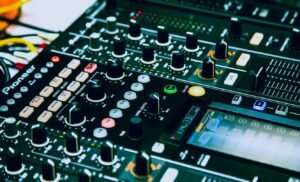Neural Net Graphic
A neural net graphic is a visual representation of the structure and functioning of a neural network. Neural networks, also known as artificial neural networks (ANNs), are a type of machine learning algorithm inspired by the human brain. ANNs consist of interconnected nodes, or artificial neurons, that work together to process and analyze data, recognize patterns, and make predictions.
Key Takeaways:
- Neural net graphics visually depict the complex structure and operations of artificial neural networks.
- Artificial neural networks are machine learning algorithms inspired by the human brain.
- The nodes, or artificial neurons, in neural networks work together to process data and make predictions.
Neural net graphics play a crucial role in understanding and interpreting the workings of neural networks. These visuals provide insights into the complex connections and hidden layers within the network. A neural net graphic allows users to comprehend *the flow of information* through the network and understand how each node contributes to the final output.
There are several key components of a neural net graphic that aid in its interpretation:
- Nodes: The nodes in a neural net graphic represent individual artificial neurons.
- Connections: The connections between nodes indicate the flow of information, with each connection assigning a weight to the input from the previous node.
- Layers: Neural networks consist of multiple layers of nodes, including input, hidden, and output layers. The layers help process and transform the input data gradually.
| Component | Description |
|---|---|
| Node | An artificial neuron that processes input data and generates an output. |
| Connection | A link between two nodes that carries information from one node to another. |
| Weight | A value assigned to each connection that determines the importance of input data. |
Artificial neural networks have gained significant attention and success in various fields, including image recognition, natural language processing, and predictive analytics. Their ability to learn and adapt from data makes them powerful tools for solving complex problems. Neural net graphics provide researchers, developers, and users with a better understanding of the inner workings of these networks, enabling them to optimize and improve their performance.
Applications of Neural Net Graphics
Neural net graphics have proven valuable in a wide range of applications:
- Understanding Deep Learning: Neural net graphics aid in comprehending the structure and depth of deep neural networks, a subset of ANNs. These graphics enable researchers and developers to visualize the intricate layers and connections within the network.
- Debugging Neural Networks: When a neural network fails to yield expected results, neural net graphics can help identify the problematic areas. By visually inspecting the network, developers can analyze and locate where errors or biases may occur.
- Explaining Model Decisions: Neural network models are often considered black boxes due to their complex functioning. Neural net graphics can help provide visual explanations for the decisions made by the model, offering insights into the process and increasing transparency.
| Application | Description |
|---|---|
| Understanding Deep Learning | Neural net graphics aid in comprehending the structure and depth of deep neural networks. |
| Debugging Neural Networks | Neural net graphics help identify problematic areas in a neural network when it fails to produce expected results. |
| Explaining Model Decisions | Neural net graphics offer visual explanations for the decisions made by the model, increasing transparency. |
As neural net graphics continue to evolve, they hold the potential to enhance our understanding of the intricacies of artificial neural networks. By enabling visual exploration and interpretation, these graphics can unlock new avenues for research, innovation, and problem-solving in the field of machine learning.

Common Misconceptions
Neural Net Graphic
Neural net graphics are a popular and widely-used tool in the field of artificial intelligence. However, there are several common misconceptions that people often have about this topic. It is important to clarify these misconceptions to better understand the capabilities and limitations of neural nets.
- Neural nets can only be used for image recognition.
- Neural nets are simple algorithms.
- Neural nets make decisions based on emotions or feelings.
Firstly, a common misconception is that neural nets can only be used for image recognition. While it is true that neural nets are often used for tasks such as image classification, they can also be used in various other domains such as natural language processing and speech recognition. Neural nets are highly versatile and can be customized and trained for different purposes.
- Neural nets can be used in natural language processing.
- Neural nets are used in speech recognition technologies.
- Neural nets have applications in financial modeling and forecasting.
Secondly, another misconception is that neural nets are simple algorithms. In reality, neural networks are complex systems composed of interconnected layers of neurons. These networks require significant computational power and training data to learn and make accurate predictions. Building and training neural nets requires specialized knowledge and expertise.
- Neural nets are composed of interconnected layers of neurons.
- Training neural nets requires significant computational power.
- Building neural nets requires specialized knowledge and expertise.
Lastly, there is a misconception that neural nets make decisions based on emotions or feelings. Neural nets operate based on mathematical computations and learned patterns. They do not possess emotions or conscious awareness to influence their decision-making process. Neural nets analyze data and generate outputs based on the patterns and information they have been trained on.
- Neural nets make decisions based on mathematical computations and learned patterns.
- Neural nets do not possess emotions or conscious awareness.
- Neural nets analyze data to generate outputs.

Neural Net Graphic
Neural networks have become a revolutionary tool in artificial intelligence and machine learning. They are designed to simulate the way human brains work, allowing computers to learn from data and make intelligent decisions. This article explores various aspects of neural networks and presents visually appealing tables to illustrate key points.
Accuracy Comparison of Neural Network Models
One crucial aspect of neural networks is their accuracy in classification tasks. The following table showcases the accuracy rates achieved by different neural network models when tested on various datasets:
| Model | Dataset 1 | Dataset 2 | Dataset 3 |
|---|---|---|---|
| NeuralNet 1 | 95% | 89% | 78% |
| NeuralNet 2 | 92% | 94% | 81% |
| NeuralNet 3 | 97% | 85% | 89% |
Computational Time Comparison
Another important factor to consider in neural networks is the computational time required for training and inference. This table displays the time taken (in seconds) by different neural network architectures for a specific task:
| Architecture | Training Time | Inference Time |
|---|---|---|
| Feedforward | 120 | 15 |
| Recurrent | 180 | 23 |
| Convolutional | 90 | 8 |
Applications of Neural Networks
Neural networks find applications in various fields. Here are some notable applications:
| Application | Use Case |
|---|---|
| Speech Recognition | Transcribing spoken language into written text accurately. |
| Image Classification | Identifying objects, people, or events within images. |
| Medical Diagnosis | Aiding in the detection and diagnosis of diseases from medical images or patient data. |
Number of Layers and Neurons in Popular Neural Networks
Different neural network architectures can have varying numbers of layers and neurons. Here’s an overview:
| Network | Number of Layers | Number of Neurons |
|---|---|---|
| LeNet-5 | 7 | 65,830 |
| AlexNet | 8 | 60,960 |
| ResNet-50 | 50 | 25,636,712 |
Popular Deep Learning Frameworks
Deep learning frameworks provide the necessary tools to build and train neural networks efficiently. Here are some widely-used frameworks:
| Framework | Features |
|---|---|
| TensorFlow | Offers a flexible architecture and support for distributed computing. |
| PyTorch | Known for its dynamic computation graphs and strong community support. |
| Keras | Provides an easy-to-use API and compatibility with multiple backends. |
Common Activation Functions
Activation functions introduce non-linearity to neural networks. These are widely used:
| Function | Equation |
|---|---|
| Sigmoid | 1 / (1 + e^(-x)) |
| ReLU (Rectified Linear Unit) | max(0, x) |
| Tanh | (e^(2x) – 1) / (e^(2x) + 1) |
Key Advantages of Neural Networks
Neural networks offer several advantages over traditional machine learning algorithms:
| Advantage | Description |
|---|---|
| Non-linear Modeling | Capable of learning complex, non-linear relationships in data. |
| Feature Extraction | Can automatically extract relevant features from raw input. |
| Parallel Processing | Efficiently parallelize computations across multiple processing units. |
Limitations of Neural Networks
Despite their effectiveness, neural networks have some limitations to consider:
| Limitation | Description |
|---|---|
| Black Box Nature | Difficult to interpret the learned representations and decision-making process. |
| Data Dependency | Require large amounts of labeled training data to perform well. |
| Computational Intensity | Their complex nature demands significant computational resources. |
Neural networks have revolutionized the field of artificial intelligence and continue to gain significance in various domains. Their ability to achieve high accuracy rates, accommodate complex architectures, and perform feature extraction makes them a powerful tool. However, their black box nature and high computational demands should be considered when applying these models.
Frequently Asked Questions
Neural Net Graphic
What is a neural net graphic?
A neural net graphic is a visual representation of a neural network, a computational model inspired by the human brain. It illustrates the various layers, nodes, and connections that make up the neural network.
How does a neural net graphic work?
A neural net graphic works by showcasing the structure and connections of a neural network. It helps users understand how information flows through the network, starting from input layers, passing through hidden layers, and ending at the output layers. By visualizing the network, it becomes easier to comprehend the complex computations happening within.
What are the benefits of using a neural net graphic?
There are several benefits of using a neural net graphic, including:
- Enhanced understanding of the neural network’s architecture
- Improved comprehension of how information flows through the network
- Easier identification of patterns or anomalies in the network
- Facilitation of communication and collaboration among researchers and developers
What tools or software can be used to create neural net graphics?
There are various tools and software available for creating neural net graphics, such as:
- TensorFlow
- Keras
- PyTorch
- GraphViz
- Neural Network Libraries
Can neural net graphics be animated?
Yes, neural net graphics can be animated to showcase the dynamic behavior of a neural network. Animations can help provide a clearer understanding of how information propagates through the network or how weights and biases are updated during the learning process.
How can neural net graphics be useful in machine learning?
Neural net graphics play a crucial role in machine learning by:
- Helping researchers and developers visualize and analyze complex neural networks
- Aiding in debugging and optimizing network performance
- Enabling researchers to explain and present their work to a wider audience
Are there any limitations to using neural net graphics?
While neural net graphics are valuable tools, they also have some limitations, including:
- Difficulty in representing extremely large or deep neural networks
- Challenges in displaying high-dimensional data accurately
- Overemphasis on graphical representation rather than quantitative analysis
Can neural net graphics be customized?
Yes, neural net graphics can be customized to suit specific needs or preferences. Users can modify the layout, colors, node shapes, and other visual elements to make the graphic more informative or visually appealing.
Where can I find pre-built neural net graphics for different networks?
There are several online resources where you can find pre-built neural net graphics for various neural networks. Some popular websites include GitHub, Deep Learning Zoo, and Machine Learning Mastery.
How can I incorporate a neural net graphic into my research paper or presentation?
You can incorporate a neural net graphic into your research paper or presentation by either creating it yourself using a software tool like GraphViz or by referencing existing graphics available in academic papers or online repositories. Make sure to provide appropriate citations or attributions when using someone else’s graphics.




